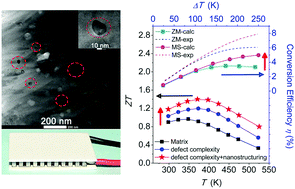当前位置:
X-MOL 学术
›
Energy Environ. Sci.
›
论文详情
Our official English website, www.x-mol.net, welcomes your
feedback! (Note: you will need to create a separate account there.)
High thermoelectric performance in Bi0.46Sb1.54Te3 nanostructured with ZnTe†
Energy & Environmental Science ( IF 32.4 ) Pub Date : 2018-03-28 00:00:00 , DOI: 10.1039/c8ee00290h Rigui Deng 1, 2, 3, 4 , Xianli Su 1, 2, 3, 4, 5 , Shiqiang Hao 6, 7, 8, 9 , Zheng Zheng 1, 2, 3, 4 , Min Zhang 1, 2, 3, 4 , Hongyao Xie 1, 2, 3, 4 , Wei Liu 1, 2, 3, 4 , Yonggao Yan 1, 2, 3, 4 , Chris Wolverton 6, 7, 8, 9 , Ctirad Uher 9, 10, 11, 12 , Mercouri G. Kanatzidis 5, 6, 7, 8, 9 , Xinfeng Tang 1, 2, 3, 4
Energy & Environmental Science ( IF 32.4 ) Pub Date : 2018-03-28 00:00:00 , DOI: 10.1039/c8ee00290h Rigui Deng 1, 2, 3, 4 , Xianli Su 1, 2, 3, 4, 5 , Shiqiang Hao 6, 7, 8, 9 , Zheng Zheng 1, 2, 3, 4 , Min Zhang 1, 2, 3, 4 , Hongyao Xie 1, 2, 3, 4 , Wei Liu 1, 2, 3, 4 , Yonggao Yan 1, 2, 3, 4 , Chris Wolverton 6, 7, 8, 9 , Ctirad Uher 9, 10, 11, 12 , Mercouri G. Kanatzidis 5, 6, 7, 8, 9 , Xinfeng Tang 1, 2, 3, 4
Affiliation

|
Defect engineering and nano-structuring are the core stratagems for improving thermoelectric properties. In bismuth telluride alloys nanosizing individual crystallites has been extensively studied in efforts to reduce the thermal conductivity, but nanostructuring with second phases has been more challenging. In this study, we demonstrate a thermoelectric figure of merit ZT of 1.4 at 400 K, realized in Zn-containing BiSbTe alloys (specifically Bi0.46Sb1.54Te3) by integrating defect complexity with nanostructuring. We have succeeded in creating nanostructured BiSbTe alloys containing ZnTe nanoprecipitates. We present a melt-spinning-based synthesis that forms in situ ZnTe nanoprecipitates to produce an extremely low lattice thermal conductivity of ∼0.35 W m−1 K−1 at 400 K, approaching the amorphous limit in the Bi2−xSbxTe3 system, while preserving the high power factor of Bi0.46Sb1.54Te3. These samples show excellent repeatability and thermal stability at temperatures up to 523 K. DFT calculations and experimental results show that Zn is inclined to form dual site defects, including two substitutional defects ZnBi/Sb′ and a Te vacancy, to achieve full charge compensation, which was further explicitly corroborated by Positron annihilation measurement. The strong enhancement of thermoelectric properties was validated in a thermoelectric module fabricated with the melt-spun p-legs (ZnTe-nanostructured BiSbTe) and zone-melt n-legs (conventional BiTeSe) which achieved a thermoelectric conversion efficiency of 5.0% when subjected to a temperature gradient of 250 K, representing about 40% improvement compared with a commercial zone-melt-based module. The results presented here represent a significant step forward for applications in thermoelectric power generation.
中文翻译:

ZnTe †纳米结构的 Bi 0.46 Sb 1.54 Te 3具有高热电性能
缺陷工程和纳米结构是改善热电性能的核心策略。在碲化铋合金中,已经广泛研究了将单个微晶纳米化的方法,以降低热导率,但是具有第二相的纳米结构化却更具挑战性。在这项研究中,我们通过将缺陷复杂性与纳米结构相结合,证明了在含锌的BiSbTe合金(特别是Bi 0.46 Sb 1.54 Te 3)中实现的在400 K时1.4的ZT热电品质因数。我们已经成功地创建了包含ZnTe纳米沉淀物的纳米结构BiSbTe合金。我们提出了一种原位形成的基于熔纺的合成ZnTe纳米沉淀在400 K时产生极低的晶格热导率〜0.35 W m -1 K -1,接近Bi 2- x Sb x Te 3体系中的非晶极限,同时保留了Bi 0.46 Sb的高功率因数1.54 Te 3。这些样品在高达523 K的温度下显示出极好的可重复性和热稳定性。DFT计算和实验结果表明Zn倾向于形成双位点缺陷,包括两个取代缺陷Zn Bi / Sb''和Te空位,以实现完全电荷补偿,正电子hil没测量进一步明确证实了这一点。在由熔纺p型腿(ZnTe-纳米结构化BiSbTe)和区域熔融n型腿(常规BiTeSe)制成的热电模块中,热电性能的强烈增强得到了验证,当经受以下操作时,热电转换效率达到5.0% 250 K的温度梯度,与市售的基于区域熔融的模块相比,提高了约40%。此处给出的结果代表了热电发电应用中的重要一步。
更新日期:2018-03-28
中文翻译:

ZnTe †纳米结构的 Bi 0.46 Sb 1.54 Te 3具有高热电性能
缺陷工程和纳米结构是改善热电性能的核心策略。在碲化铋合金中,已经广泛研究了将单个微晶纳米化的方法,以降低热导率,但是具有第二相的纳米结构化却更具挑战性。在这项研究中,我们通过将缺陷复杂性与纳米结构相结合,证明了在含锌的BiSbTe合金(特别是Bi 0.46 Sb 1.54 Te 3)中实现的在400 K时1.4的ZT热电品质因数。我们已经成功地创建了包含ZnTe纳米沉淀物的纳米结构BiSbTe合金。我们提出了一种原位形成的基于熔纺的合成ZnTe纳米沉淀在400 K时产生极低的晶格热导率〜0.35 W m -1 K -1,接近Bi 2- x Sb x Te 3体系中的非晶极限,同时保留了Bi 0.46 Sb的高功率因数1.54 Te 3。这些样品在高达523 K的温度下显示出极好的可重复性和热稳定性。DFT计算和实验结果表明Zn倾向于形成双位点缺陷,包括两个取代缺陷Zn Bi / Sb''和Te空位,以实现完全电荷补偿,正电子hil没测量进一步明确证实了这一点。在由熔纺p型腿(ZnTe-纳米结构化BiSbTe)和区域熔融n型腿(常规BiTeSe)制成的热电模块中,热电性能的强烈增强得到了验证,当经受以下操作时,热电转换效率达到5.0% 250 K的温度梯度,与市售的基于区域熔融的模块相比,提高了约40%。此处给出的结果代表了热电发电应用中的重要一步。











































 京公网安备 11010802027423号
京公网安备 11010802027423号